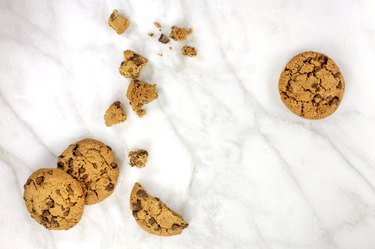Finding a gluten-free alternative to pasta noodles can be both challenging and exciting. You could try mung bean noodles, which are also known as cellophane noodles and are a common food in Chinese cuisine. In America, this noodle alternative is growing in popularity.
Mung bean noodles can be used in gluten-free cooking. They share properties of the mung bean but are still considered processed. You receive more nutrients and benefits when consuming whole mung beans.
Like other alternative noodles like red lentil pasta and brown rice pasta, mung bean noodles come from a whole food. However, they are dehydrated and strung together from mung bean starch. This makes them a processed food. During the process of making mung bean noodles, some nutrients are lost.
If you have celiac disease or are allergic to gluten, mung bean noodles may be a better choice than regular noodles. However, they are not as healthy as the mung beans they come from. Though they are somewhat processed, mung bean noodles do not contain many added ingredients.
Mung bean noodles, also known as glass noodles, cellophane noodles, or bean thread noodles, have become a popular gluten-free pasta alternative. Made from the starch of mung beans, these translucent noodles have a springy, gelatinous texture when cooked. They are commonly used in Chinese and Asian cuisine, but their popularity has steadily grown in the West as more people seek out gluten-free or low-carb pasta swaps. But are these noodles made from beans really a healthy choice? Let’s take a closer look at the nutritional profile and potential benefits of mung bean noodles.
A Brief History of Mung Bean Noodles
Mung bean noodles have been used in Asian cooking for centuries. Mung beans are native to India and have been cultivated since approximately 1500 BC. China later adopted the bean as a staple crop around 400 AD. By extracting starch from ground mung beans and reconstituting it into noodle form cooks created a gluten-free noodle option that has stood the test of time.
While mung bean noodles have long been a staple of Chinese cuisine, their popularity spread as Chinese immigrants brought their cuisine abroad throughout the 1900s. The noodles are now commonplace in many Asian supermarkets and restaurants around the world. Their gluten-free qualities and assumed health benefits have also led to rising popularity in health-focused Western markets.
Nutritional Profile of Mung Bean Noodles
Mung bean noodles are often touted as a high-protein low-carb pasta alternative. But does the nutritional profile actually support these claims?
Let’s compare the nutrition facts of 1 cup of cooked mung bean noodles versus 1 cup of cooked traditional wheat spaghetti pasta:
| Mung Bean Noodles | Wheat Spaghetti
|-|-|-|
Calories | 160 | 221
Fat | 0g | 1g
Carbs | 40g | 43g
Fiber | 0g | 2g
Protein | 1g | 8g
As you can see, mung bean noodles have slightly fewer calories and carbs compared to wheat pasta. However, they also have less protein and fiber. Since mung bean noodles undergo starch extraction and processing, some nutrients are lost from the whole mung bean.
Additionally, mung bean noodles have minimal fat, but they lack the range of vitamins and minerals found in whole mung beans. Overall, while mung bean noodles make a suitable gluten-free swap for wheat noodles, they do not boast a distinctly superior nutritional profile.
Potential Health Benefits of Mung Bean Noodles
Though not nutritional powerhouses, mung bean noodles still offer some potential health upsides:
Gluten-free: Mung bean noodles are safe for people with celiac disease or gluten intolerances. They provide texture and satisfaction for carb cravings without gluten exposure.
Low-carb: With 40g net carbs per cup, mung bean noodles offer a slightly lower-carb alternative to wheat noodles’ 43g per cup. This makes them suitable for some low-carb, keto, or diabetic diets when used in moderation.
Rich in antioxidants: Mung beans contain antioxidant polyphenols that may help reduce inflammation and oxidative stress when consumed in their whole food form. Mung bean noodles retain some of this benefit.
High in iron: Mung bean noodles provide around 5% of your daily recommended iron intake per cup. Iron supports healthy blood and energy levels.
Prebiotic fiber potential: Some mung bean noodle brands retain a small amount of fiber, which may help support gut bacteria as a prebiotic.
Versatility: Mung bean noodles can be used as a substitute for wheat noodles in many dishes, providing more menu flexibility.
So while mung bean noodles are not a nutritional panacea, they do offer some advantages that make them a smart ingredient to keep in your gluten-free arsenal.
Downsides and Considerations
Mung bean noodles also come with a few downsides to consider:
-
Since they are processed and stripped of fiber, mung bean noodles lack the full nutritional benefits of whole mung beans. They are considered a more refined choice.
-
With only 1g of protein per cup, mung bean noodles do not provide the satisfying protein punch of wheat pasta or whole mung beans. They have a more starch-based macros profile.
-
At 40g net carbs per cup, mung bean noodles are still a high-carb choice. Portion control is needed, especially for low-carb diets.
-
Transparency and minimal ingredients are key. Some mass-produced mung bean noodle brands add unnecessary fillers and additives.
-
Those with legume allergies, IBS, or gut issues may experience discomfort from mung bean noodles due to digestive difficulties properly breaking down bean starch.
Healthiest Ways To Enjoy Mung Bean Noodles
To maximize the nutritional benefits of mung bean noodles, enjoy them in healthy recipes like:
-
Vegetable stir-fries: Mix mung bean noodles with plenty of fresh veggies like bok choy, broccoli, bell peppers, mushrooms, etc. for added nutrients.
-
Protein and veggie bowls: Top mung bean noodle bowls with shrimp, eggs, chicken, or tofu along with vegetables to balance the meal.
-
Nutrient-rich soups: Add mung bean noodles to soups packed with immune-boosting ingredients like mushrooms, garlic, leafy greens, etc.
-
Peanut sauce: Dress mung bean noodles with a protein-rich peanut sauce made with natural peanut butter for staying power.
-
Sparing amounts: Use mung bean noodles as a small part of a meal with other wholesome foods for proper portion size.
The Bottom Line: Are Mung Bean Noodles Healthy?
Mung bean noodles can be a suitable component of a balanced, gluten-free diet, but they should not be treated as a nutritional hero. While convenient and versatile, mung bean noodles are still a processed food stripped of the full benefits of whole mung beans. Portion control is key, as mung bean noodles are still a starch-based carb. Luckily, they absorb surrounding flavors well, so mix them into recipes packed with fresh veggies, quality protein, healthy fats, and antimicrobial ingredients for an optimal nutritional profile. Ultimately, mung bean noodles should be enjoyed in moderation as part of an overall healthy eating pattern.
Frequently Asked Questions
Are mung bean noodles keto-friendly?
Mung bean noodles are not strictly keto, since they contain around 40g net carbs per cup. However, incorporating them sparingly into keto meals in small amounts can add variety. Pair them with low-carb proteins and healthy fats to help balance their carbs.
What is the best way to prepare mung bean noodles?
Rinse dry mung bean noodles well, then soak in hot water for 5-15 minutes until softened. Drain then add to stir-fries, soups, noodle dishes, etc. Be careful not to overcook them into mush.
Do mung bean noodles contain nutrients?
Mung bean noodles retain a small amount of iron and antioxidants from the mung beans, but most vitamins, minerals, fiber and protein are stripped away during processing. They lack the full nutritional profile of whole mung beans.
Are mung bean noodles low glycemic?
No, mung bean noodles have a high glycemic index of around 70. Their refined starch profile causes a rapid spike in blood sugar. Portion control is especially important for diabetics and those controlling blood sugar levels.
Can you eat mung bean noodles raw?
It is not recommended to eat raw mung bean noodles. Always cook them first to avoid potential digestive upset and properly soften their texture. Mung bean starch needs heat to become palatable.

k
Glass Noodles Nutrition Facts
Mung bean noodles are advertised as a healthier alternative to traditional pasta. People who follow a gluten-free diet use them in noodle dishes. Cellophane noodles are also advertised as a high-protein, low-carb option. However, glass noodles nutrition facts do not support these claims.
According to the USDA, 1 cup of cooked mung bean noodles contain the following nutrition facts:
- 160 calories
- 0.019 grams of fat
- 39.3 grams of carbohydrates
- 0.19 grams of fiber
- 0.076 grams of protein
- 4.7 percent daily value (DV) of iron
At 160 calories per cup, glass noodles have the same number of calories as other types of noodles. This number does not include any other ingredients like broth, tofu, or vegetables. Since the mung bean starch is extracted, cellphone noodles are high in carbohydrates.
In comparison, 1 cup of cooked mung beans contain the following nutrition facts per the USDA:
- 212 calories
- 0.8 grams of fat
- 38.7 grams of carbohydrates
- 14.2 grams of protein
- 15.4 grams of fiber
- 23 percent DV of magnesium
- 16 percent DV of iron
It is common for processed foods to have less protein, fiber, vitamins, and minerals. Glass noodles are no different.
Read more: Why the Green Gram Is Being Touted as the Next Superfood
What are Mung Bean Noodles?
Mung bean noodles have multiple names, including cellophane noodles and glass noodles. They get these names from their transparent appearance. To make mung bean noodles, mung bean starch is extracted, dehydrated and formed into a noodle shape.
Despite looking spongy and soft to the touch, cooked mung bean noodles are firm like cooked wheat noodles. Their texture makes them a suitable alternative to semolina wheat pasta. In Chinese cuisine, cellophane noodles are used in stir fries and noodle dishes.
Mung bean noodles tend to have simple ingredient lists. Depending on the brand or manufacturer, mung bean noodles and water may be the only ingredients.



